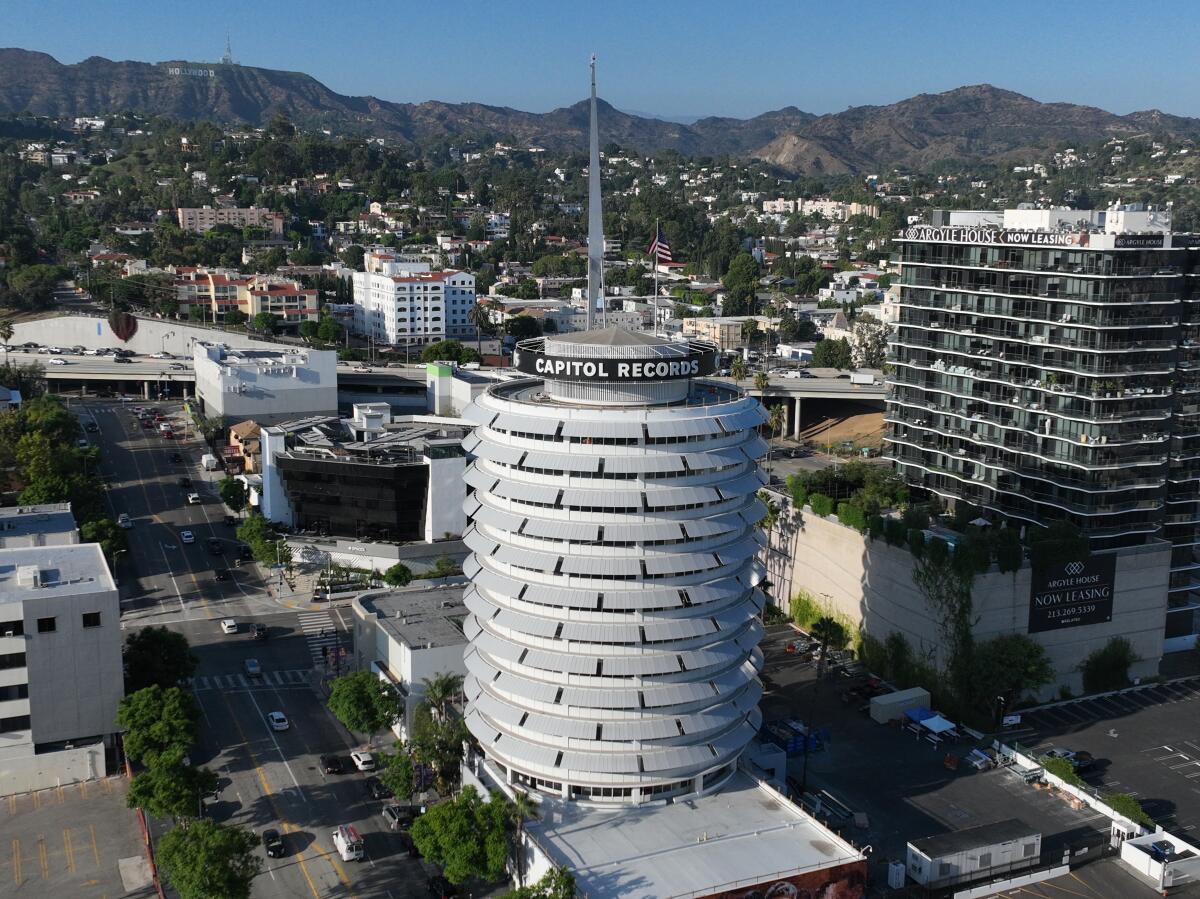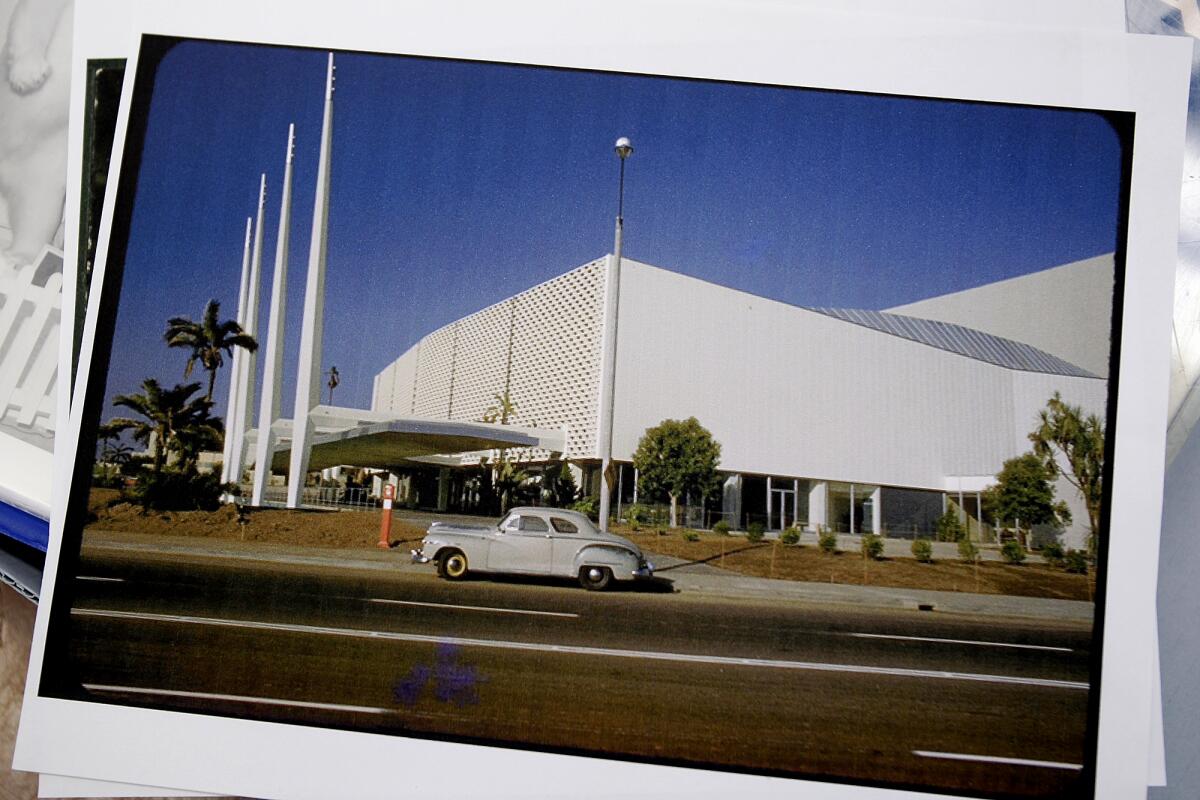Louis Naidorf, the visionary architect behind the long-lasting Capitol Information Constructing, died Wednesday night time of pure causes. He was 96. His loss of life was confirmed by Naidorf’s longtime good friend Mike Harkins. Naidorf’s distinctive method to architectural design, mixing logic with creativity and performance with feeling, helped outline the Los Angeles cityscape.
Although greatest recognized for the enduring Los Angeles landmark, which opened its doorways in 1956 and was formally designated a Los Angeles Historic-Cultural Monument in 2006, Naidorf’s legacy spans far past the legendary round tower, which was the world’s first spherical workplace constructing.
His notable physique of labor contains the Santa Monica Civic Auditorium, the now-demolished L.A. Memorial Sports activities Area, the Beverly Middle, the Beverly Hilton lodge, and the Ronald Reagan State Constructing. Past Los Angeles, he led the six-year restoration of the California State Capitol in Sacramento, and designed the Rancho Mirage residence of former President Gerald Ford and First Girl Betty Ford.
Naidorf’s architectural oeuvre additionally extends outdoors California’s borders. He designed Phoenix’s Valley Nationwide Financial institution constructing (now Chase Tower), the tallest construction in Arizona; and the Hyatt Regency Dallas and its adjoining Reunion Tower, a defining characteristic of town’s skyline.
Born Louis Murray Naidorf on Aug. 15, 1928, in Los Angeles, he formed his future with the identical purposefulness and tenacity he dropped at his buildings. His dad and mom, Jack and Meriam Naidorf, each labored within the girls’s clothes trade and infrequently struggled financially. However younger Naidorf, who was already sketching cities by age 8, was too busy dreaming about structure to note.
Lou Naidorf in entrance of the Capitol Information constructing, one among a number of Los Angeles landmarks he designed, for example story on his retirement after 10 years as dean of structure at Woodbury College.
(Al Seib/Los Angeles Instances)
At 12, he started gathering structure books, paying for them together with his part-time job earnings. After receiving drafting instruments for his thirteenth birthday, he approached native architect Sanford Kent and requested for a job. Impressed by his initiative, Kent mentored Naidorf, paying him out of pocket.
Naidorf later studied structure at UC Berkeley. In his 1950 grasp’s thesis, Naidorf imagined a future during which computer systems would proliferate and develop into compact, eliminating the necessity for sprawling places of work. To optimize house, he proposed a daring new idea — round workplace buildings — unwittingly foreshadowing what would later develop into his most iconic challenge.
After graduating on the prime of his class, and incomes his grasp of structure diploma a yr early, Naidorf skipped his graduation ceremony to interview at powerhouse structure agency Welton Becket and Associates. He was employed on the spot.

Aerial drone view of the long-lasting and historic Capitol Information Constructing in Hollywood.
(Allen J. Schaben / Los Angeles Instances)
Three years later, at 24, he was entrusted together with his first main task, the mysterious “Mission X.” Shrouded in secrecy, Naidorf was given scant data aside from the constructing’s dimensions and placement. He had no concept that it could develop into the headquarters of Capitol Information. But struck by parallels between his thesis and the challenge’s comparatively modest dimension, he utilized the spherical form to the constructing. He additionally aimed to design a “pleased constructing,” each for its inhabitants and passersby.
All through his life, Naidorf usually refuted the parable that the constructing was designed to resemble a stack of data. Even so, guided by his core precept of bringing pleasure to individuals, he would say, “If it makes individuals pleased to assume that, so be it.”
Recognized for his humor and humility, he would joke that Capitol Information-shaped birthday truffles inevitably collapsed due to a “structural flaw,” playfully suggesting a weak point within the constructing’s design, and he was endlessly amused by the constructing’s repeated destruction in catastrophe films.
Dedicated to mentoring the subsequent technology of architects, Naidorf served as a visitor professor at UCLA, USC, Cal Poly Pomona and SCI-Arc. In 1990, he grew to become a full-time tutorial, beginning as chair and later turning into dean of Woodbury College’s College of Structure, the place he earned a number of distinctions, together with trainer and school member of the yr honors.
He inspired college students to be well-rounded and curious in regards to the world so they might join with future shoppers on a human degree, and to develop distinctive views that will inform their designs.
Whilst he rose to vp, director of analysis, and director of design at his agency — and earned quite a few honors together with the AIA California Lifetime Achievement Award in 2009 — he remained grounded, usually saying actual life occurs outdoors buildings: sitting at cafés with buddies or having fun with a day on the park.

An early {photograph} of the Santa Monica Civic Auditorium, one other iconic constructing designed by Naidorf.
(Christina Home / Los Angeles Instances)
Naidorf’s deep humanity, mirrored within the title of his now out-of-print 2018 memoir, “Extra Humane: An Architectural Memoir,” prolonged to all residing issues, together with doting on his 13-year-old cat, Ziggy Starburst, with whom he shared a birthday — and even small creatures in misery, like a dying bee that he discovered on his kitchen flooring that he carried outdoors to die, as he put it, “with dignity in nature,” and a snail with a damaged shell in his yard that he gently tended to.
A voracious reader, Naidorf was particularly keen on science magazines and pondering the cosmos. He additionally loved classical music. A lifelong traveler, he visited Canada, Japan, China, South Korea and Taiwan, and made greater than two dozen journeys to Europe.
In 2000, drawn by Northern California’s magnificence, Naidorf relocated to Santa Rosa, the place he labored as a campus architect for Woodbury College and collaborated with Metropolis Imaginative and prescient Santa Rosa to reinforce the downtown.
Although he retired at 87, he saved his structure license lively, taking his renewal exams yearly. Holding the oldest lively license in California, issued in 1952, he vowed to be buried as a licensed architect — and so he shall be.
Twice divorced and twice widowed, Naidorf was married 4 occasions, and overcame most cancers twice. He’s survived by his daughter, Victoria, from his first marriage; 4 stepchildren from his fourth marriage, all of whom known as him Dad; 11 grandchildren; and 6 great-grandchildren.

